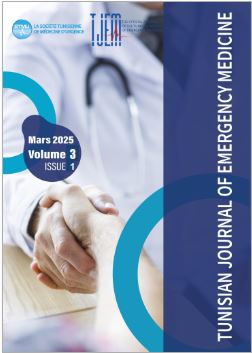Management of Bell palsy: our clinical practice guideline
DOI:
https://doi.org/10.0000/ysyn5n25Keywords:
Bell’s palsy, corticotherapy, facial nerve, physical therapyAbstract
Bell palsy is a frequent neurologic disorder defined by an acute mononeuropathy affecting the seventh cranial nerve presenting with ipsilateral facial weakness. It remains the most common etiology of facial nerve paralysis.
This is a retrospective study which identified 75 cases of Bell’s palsy from the medical records of the ENT department of Regional Hospital of Sidi Bouzid from January 2020 to December 2022.
Our series consisted of 17 children and 58 adults, with an average age of 37 years (range: 3 – 88 years). All patients consulted for an unilateral facial asymmetry. Initial assessment according to the House-and-Brackmann grading found 5 patients with grade I, 16 patients with grade II, 24 patients with grade III, 27 patients with grade IV, and 3 patients with grade V. Treatment was conducted in an outpatient setting in 64 patients. Hospitalization was required within 11 patients. Corticoids were initiated in 64 patients. Antiviral treatment, always in association with corticotherapy, was indicated within 21 patients, with a mean consultation delay of 3 days. All patients were given a vasodilator and vitamin therapy. Rehabilitation facial therapy was initiated in all cases, with a mean delay of 7 days. The objective of this study is to review the therapeutic management guideline of the patients presented with idiopathic facial nerve paralysis in our department in a comparison with the relevant literature.
Downloads
Published
Issue
Section
License
Copyright (c) 2025 Tunisian Journal of Emergency Medicine

This work is licensed under a Creative Commons Attribution-NonCommercial-ShareAlike 4.0 International License.
How to Cite
Similar Articles
- Faten DHOUIB, Aimen Dammak, Faiza Safi, Fatma MHIRI, zied CHAARI, Successful Conservative Management of Penetrating Cervical Tracheal Injury: A Case Report , Tunisian Journal of Emergency Medicine: Vol. 3 No. 1 (2025): TJEM 2025: Vol.3 Issue 1
- Neila MAAROUFI, Firas Kessentini, Sabra Ouaz, Meriem Jemili, Moufida Nouari, Jihen Lakhal, Bilateral ptosis caused by midbrain hemorrhage: a case report , Tunisian Journal of Emergency Medicine: Vol. 3 No. 1 (2025): TJEM 2025: Vol.3 Issue 1
- Rania Hammami, Syrine Triki, Aimen Dammak, Faiza Safi, Olfa Chakroun , An abrupt cardiogenic shock in a female at the era of COVID 19 pandemic lockdown , Tunisian Journal of Emergency Medicine: Vol. 3 No. 1 (2025): TJEM 2025: Vol.3 Issue 1
- mahmoud ladhar, Chourouk Frikha, Manel Feki, Mouna Loukil, Faiza Safi, Mortality in Pediatric Intensive Care , Tunisian Journal of Emergency Medicine: Vol. 3 No. 2 (2025): TJEM 2025: Vol.3 Issue 2
- Fatma Hbaieb, Low Back Pain Revealing Bilateral ProximalPulmonary Embolism with COVID-19 , Tunisian Journal of Emergency Medicine: Vol. 2 No. 4 (2024): TJEM Vol2 Issue4
- Haifa BRADAÏ, Rabeb Mbarek, Sondes Laajimi, Dorra Loghmari, Mounir NAIJA, Atrial flutter mimicking ST-elevation myocardial infarction: A case report , Tunisian Journal of Emergency Medicine: Vol. 3 No. 1 (2025): TJEM 2025: Vol.3 Issue 1
- randa dhaoui, A complicated pulmonary hydatid cyst mimickingpneumonia: A case report , Tunisian Journal of Emergency Medicine: Vol. 2 No. 4 (2024): TJEM Vol2 Issue4
- safia othmani, Ischemic acute cholecystitis: a case report , Tunisian Journal of Emergency Medicine: Vol. 2 No. 4 (2024): TJEM Vol2 Issue4
- Sarra Akkari , Emna Rachdi , Jalila Ben Khlil , Prognosis in COVID-19: Impact of Pre-hospital Emergency Care , Tunisian Journal of Emergency Medicine: Vol. 2 No. 4 (2024): TJEM Vol2 Issue4
- Hanen GHAZELI, De Winters ST-T syndrome: an early sign of STsegment elevation myocardial infarction (A case report) , Tunisian Journal of Emergency Medicine: Vol. 2 No. 2 (2022): TJEM Vol2 Issue2
You may also start an advanced similarity search for this article.

